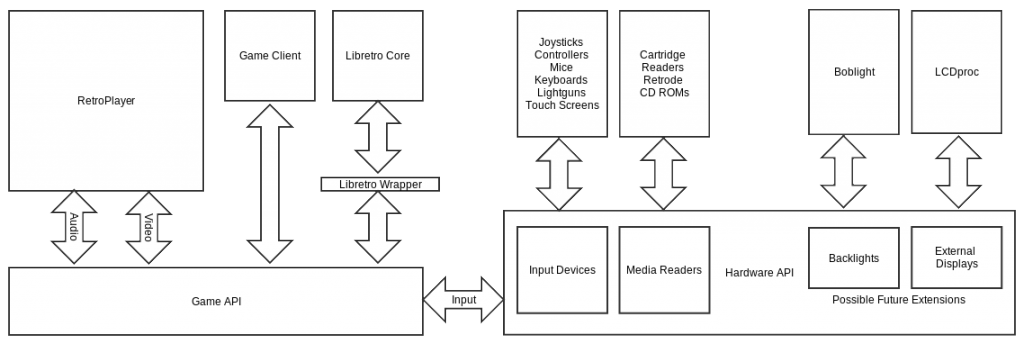Posts: 2,863
Joined: Dec 2010
Reputation:
281
garbear
Team-Kodi Developer
Posts: 2,863
you'll notice the only functional difference is that RetroPlayer is no longer connected to any input. I've re-written the joystick API two or three times, and the end result was never satisfactory because I couldn't separate the input from retroplayer. now, with input gone, the complexity of retroplayer is greatly reduced, leading to more maintainable code.
putting as much code as possible behind APIs is generally a good strategy. i learned this rather late in the development of retroplayer, so there are still quite a few parts that are entangled. however, looking at this diagram, i think i'm on the right track - components are finally only communicating with their API, and not with other components
Posts: 40
Joined: Mar 2013
Reputation:
0
Thanks for the update and keep up the good work. I agree that anything that simplifies the core functionality and gets this into mainline sooner is a great thing for future progress.
Posts: 7
Joined: Nov 2014
Reputation:
0
2014-11-08, 13:51
(This post was last modified: 2014-11-08, 15:19 by Scr3wdriv3r.)
If this is to become a integrated thing in XBMC, would that mean it runs on everything that runs XBMC?
Reason I ask is because I recently bought a Pivos XIOS XS, that ran on Android, but I turned to this version from Hydra and would love the possibility to play games on XBMC, but I am not sure if Retroplayer is already capable on ARM.
XBMC Linux Firmware Release #: the-hydra-xbmc-Linux-XIOS-XS-gotham-13-2-mk2-20141017
Revision Date: 20141017 - Feature Linux MX 3.0.101 kernel
Would similar but future versions of such builds have this integrated as well (just recently started using XBMC/Kodi)?
Posts: 4
Joined: Jan 2015
Reputation:
0
I look forward to the day i get my hands on an official release of Retroplayer ! Keep up the good work and keep it coming.
Posts: 3,384
Joined: Aug 2012
Reputation:
107
braz
Skilled Skinner
Posts: 3,384
What is the relationship between RetroPlayer and Rom Collection Browser? Will RCB become unnecessary once RetroPlayer is released? I only ask because I am thinking of skinning RCB for my local Windows games, but am willing to wait if RetroPlayer will include this same functionality. Thanks!


